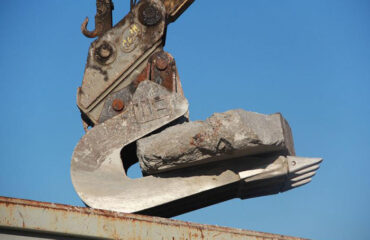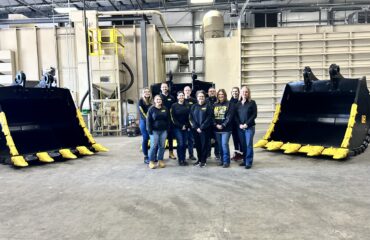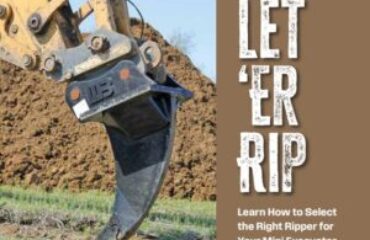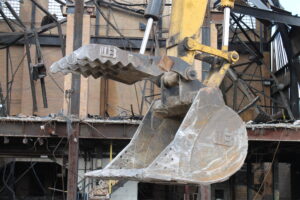 When selecting an excavator thumb, many operators and contractors find themselves facing a myriad of questions. By applying a fair approach and looking at the advantages and disadvantages of each, let’s tackle the key inquiries to help guide your decision:
When selecting an excavator thumb, many operators and contractors find themselves facing a myriad of questions. By applying a fair approach and looking at the advantages and disadvantages of each, let’s tackle the key inquiries to help guide your decision:
What is an Excavator Thumb?
An excavator thumb is an accessory that mimics a human thumb, aiding your equipment in grasping, holding, and moving various materials that may be challenging to pick up using only a bucket. The bucket and thumb work together to pick up objects such as rocks, logs, debris, and other materials. Typically, it enhances the versatility and functionality of an excavator, making it a valuable tool on construction sites and in applications such as land clearing, demolition, and material handling. They come in a variety of configurations including hydraulic and mechanical as well as a range of styles, shapes, and quantity of tines.
What Types of Excavator Thumbs are Available?
1. Main Pin Thumb
Description: Known for rotating up to 120 degrees, this thumb is the most common, especially within compact equipment.
Advantages: Popular due to its robustness and suitability for general applications. Typically, it’s custom in nature, designed around the unique machines set up. Operates on the same axis as the bucket and travels with it for most of its rotation.
Disadvantages: These thumbs take more time to take on and off compared to a stick mounted universal. This design lacks the ability to rotate the entire path of the bucket. Often you will have to wait for the thumb to be built to your configuration; although some companies, like Werk-Brau, have a standard offering that they stock.
2. Stick-Mounted Thumb
Description: This budget-friendly choice works on its own axis and is compatible with multiple bucket types. It is typically easy to remove in case you would not want a thumb on the machine. It is universal in nature and designed to work in a lot of applications.
Advantages: Universal design; available in both hydraulic and rigid versions for diverse needs.
Disadvantages: Offers a limit to approximately 130 degrees of rotation and may present challenges due to its independent operation axis. This thumb is universal, as the name implies, meaning it will not be designed specifically to your set up and therefore likely not going to mesh with your buckets. Often you will need to trim the tines to fit the specific tip radius requirements of your bucket.
3. Progressive Link Thumb
Description: The priciest and most versatile option, adding an extra 60 degrees of rotation beyond the standard main pin. This thumb will track with the full rotation of the bucket. Often these thumbs will be custom made to the setup of your machine.
Advantages: Enhances the efficacy of skilled operators and adapts to a variety of tasks while reducing the need to travel the machine due to the nimble design. You can reach out, pick and work close without resetting the machine and giving you better reach.
Disadvantages: This thumb is the most expensive of the different styles available. It also will be heavier than the other two styles mentioned.
What Are the Advantages and Disadvantages?
The choice of an excavator thumb is contingent upon the task requirements and budget. Progressive link thumbs stand out for their flexibility and ability to significantly improve work precision. Conversely, stick-mounted thumbs offer a cost-effective solution but with potential operational caveats due to their design. Most contractors and excavator operators find themselves needing something versatile with a broad range of applications the thumb might get used in.
How Do the Design and Functionality Vary?
What questions should you ask yourself as you decide what thumb is right for you and, more importantly, where you should buy it?
Dealer relationship: It is critical to build a strong foundational relationship with your dealer and make sure that they fully understand your business and what your goals are for the future. If they are not asking questions about how you look to utilize this tool in the future, I would suggest looking for another option.
Manufacture Brand: What is the brand reputation and longevity of the company that is building your thumb? Are they based domestically, or do they farm out their production to another country? With today’s market, asking the question about where it’s made is critical especially when considering the impact of steel tariffs for example. Also, will that company have replacement parts ready for when you need them? When a thumb goes down, it’s critical to get back up and run as quickly as possible to avoid any delays costing you money.
Engineering and constant improvement: When looking at thumb design, it’s important to look at the structure and materials they are using.
- Does the thumb lay back as close to the stick; out of the way when not using?
- What do the welds look like?
- Do they stand behind what they build?
Lead time: In today’s world we need everything now! The “Amazon effect” has created an environment where timing is becoming increasingly critical. So, ask yourself, “How does this manufacture do in holding their lead time commitments, especially when getting a custom thumb designed?”
Excavator thumbs need to be crafted with attention to detail, incorporating components such as:
Cylinder Mount & Base: Essential for hydraulic operation. Ask how large it is and how much welding on the stick is required.
Thumb Arm: Connects to the tines, playing a crucial role in the thumb’s stability and movement.
Pivot Pin: Central to the thumb’s rotation and functionality. Ask what materials are being used and how is it retained.
Thumb structure: Ask what materials make up the main thumb body. Do they use tube steel, for example, for strength and rigidity?
Bushings: When you use a thumb a lot you will generate a tremendous amount of friction over time. Find out what bushings they use and whether they are high quality. Ask yourself, how well they are bringing grease to the right areas of the pivot pin?
Additional features like the cylinder’s stop pad reinforce stability and safety during operation.
How do I decide what tine configuration I need?
Step 1: Understand Your Requirements
Type of Material: Consider what materials you will be handling most often. For example, large, irregular items like rocks or logs may require different tine spacing compared to smaller debris.
Expected Tasks: Define whether you need a thumb for demolition, land clearing, or material handling, as this will also influence the design choice.
Step 2: Know Your Bucket
Bucket Size: Measure the tip radius to select a thumb with compatible dimensions.
Bucket Shape: The profile of the bucket (curved or flat) will affect how the thumb tines mesh with it. It’s typically best to try to keep the same manufacturer for both bucket and thumb to ensure fitment will be perfect. However, with good measurements, this is not necessary.
Bucket teeth: What type of teeth do you have and how many are there?
Expected Tasks: Measure the width of each tooth and the spacing between the teeth. Be sure to check all and make sure they are evenly spaced or note that for the manufacturer designing the thumb.
Step 3: Decide on Tine Design
Tine Spacing: This is critical to your bucket specs and number of teeth in order to select the correct number of tines. If you want to mesh with the bucket, you will need to know what you have to mesh correctly. Often you will see odd tooth quantity buckets working with even tine quantity thumbs and vice versa. This allows the mesh to happen.
Number of Tines: More tines provide better grip but can add weight. Balance between coverage and efficiency.
Tine Shape: Curved tines ensure better grip around materials such as wide logs or rocks, while straight tines are simpler and work for general purposes. They also will hang down less from the stick in the retracted position.
Step 4: Consider Material and Durability
Material Quality: Choose tines made from high-strength steel for improved durability and longevity.
Wear Resistance: Look for options with added wear-resistant features if you are working in abrasive environments. Are the tines serrated or not? A serrated tine will give you a better grip on what you are trying to pick up or hold in the bucket.
Step 5: Choose Between Hydraulic or Mechanical
Hydraulic Thumbs: Offer adjustable positions and greater control, suitable for tasks requiring precision.
Mechanical Thumbs: They’re simpler, cost-effective, and work well for straightforward applications.
Step 6: Compatibility and Installation
Attachment Mechanism: Ensure that the thumb you choose is compatible with your excavator’s mounting style. Be sure to note if you have an OEM mount already installed on your stick. Also note, if you go with a stick mounted thumb or a progressive link you are most likely going to have to cut that mount off to make room for the correct mount from the thumb manufacturer.
Professional Installation: Consider having the thumb installed by a professional to ensure proper alignment and operation.
Step 7: Consult with a Dealer or Manufacturer
Expert Advice: Discuss your needs with a dealer or manufacturer to get recommendations on thumb configurations that best match your excavator and workload.
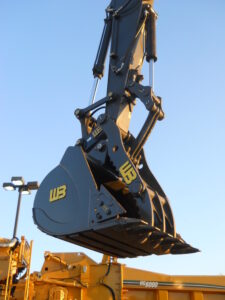
What Should You Ensure Before Making a Purchase?
1. Review Resources: Check practical installation videos, such as Diesel Creek’s YouTube content on full-size excavator thumb installation, which shows a full installation of the Werk-Brau thumb for insights.
2. Understand Compatibility: Before finalizing a purchase, verify the geometry and clearances to prevent interference issues between the thumb, coupler, and bucket.
3. Understand Limitations: Ensure you understand the universal design features and possible limitations associated with stick-mounted thumbs. Or if you are purchasing a main pin, understand the limitation in rotation compared to a progressive link. Depending on the bucket and coupler you choose, you may have to worry about the thumb or bucket contacting the cab or stick, which could require trimming of the center tines or careful operation for example.
By answering these critical questions, you can make an informed decision on the best excavator thumb for your needs, enhancing your equipment’s performance and your project’s efficiency.

